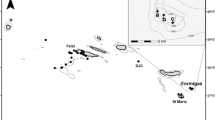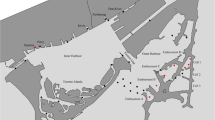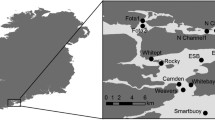Abstract
Fish movement patterns are an essential consideration for the design of effective freshwater protected areas. The Rideau waterway system (Ontario, Canada) is home to some of the oldest single-resource freshwater protected areas (FPAs) in Ontario (> 70 years active). Initially, these FPAs were intended to provide holistic protection to the heavily exploited largemouth bass, but since their establishment, little is known regarding their protective capacity. Using a passive acoustic telemetry network, we measured how site fidelity varied with body size and across seasons in largemouth bass within one Rideau waterway FPA. Collectively, 50 bass were tracked for an average of 227 days, with some individuals tracked upwards of 744 days. Tagged fish spent on average 55% of their time at liberty within the FPA, with occupancy rates exceeding 85% for some individuals. Most of the tagged fish displayed cyclical movement behaviour between the FPA and non-protected areas, largely corresponding with known life-history stages. Largemouth bass occupancy was highest in the spring–summer seasons (i.e. reproductive period), with a sharp decline during the autumn that sustained through the winter. FPA occupancy varied with body size, with large fish (> 430 mm) using the FPA more extensively. Our findings show that this Rideau waterway FPA provides temporal protection from exploitation to a highly targeted sportfish, especially during their reproductive period, likely providing major conservation benefits. These findings also highlight the value of considering the habitat requirements of a species across life stages to inform effective FPA design.





Similar content being viewed by others
Data availability
All data are accessible upon request from the corresponding author.
References
Abell R, Allan JD, Lehner B (2007) Unlocking the potential of protected areas for freshwaters. Biol Conserv 134:48–63. https://doi.org/10.1016/j.biocon.2006.08.017
Abrams AEI, Rous AM, Brooks JL et al (2018) Comparing immobilization, recovery, and stress indicators associated with electric fish handling gloves and a portable electrosedation system. Trans Am Fish Soc 147:390–399. https://doi.org/10.1002/tafs.10034
Acreman M, Dueñas M, Hughes KA et al (2020) Protected areas and freshwater biodiversity: a novel systematic review distils eight lessons for effective conservation. Conserv Lett. https://doi.org/10.1111/conl.12684
Ahrenstorff TD, Sass GG, Helmus MR (2009) The influence of littoral zone coarse woody habitat on home range size, spatial distribution, and feeding ecology of largemouth bass (Micropterus salmoides). Hydrobiologia 623:223–233. https://doi.org/10.1007/s10750-008-9660-1
Ashley M, Willson MF, Pergams ORW et al (2003) Evolutionarily enlightened management. Biol Conserv 111:115–123
Breiman L (2001) Random forests. Mach Learn 1:5–32. https://doi.org/10.1023/A:1010933404324
Breiman L, Friedman JH, Olshen RA, Stone CJ (1984) Classification and regression trees. Biometrics 40:874
Brown TG, Runciman B, Pollard S, Grant ADA (2009) Biological synopsis of largemouth bass (Micropterus salmoides). Can Manuscr Rep Fish Aquat Sci 2884:1–27
Cargnelli LM, Gross MR (1997) Fish energetics: larger individuals emerge from winter in better condition. Trans Am Fish Soc 126:153–156. https://doi.org/10.1577/1548-8659(1997)126%3c0153:NFELIE%3e2.3.CO;2
Carlson DM (1992) Importance of wintering refugia to the largemouth bass fishery in the Hudson River Estuary. J Freshw Ecol 7:173–180. https://doi.org/10.1080/02705060.1992.9664682
Colborne SF, Hondorp DW, Holbrook CM, Lowe MR, Boase JC, Chiotti JA, Wills TC, Roseman EF, Krueger CC (2019) Sequence analysis and acoustic tracking of individual lake sturgeon identify multiple patterns of river–lake habitat use. Ecosphere 10(12):e02983. https://doi.org/10.1002/ecs2.v10.12
Cooke SJ, Philipp DP, Wahl DH, Weatherhead PJ (2006) Energetics of parental care in six syntopic centrarchid fishes. Oecologia 148:235–249. https://doi.org/10.1007/s00442-006-0375-6
Cooke ELL, Wilson ADM, Elvidge CK, Cooke SJ (2017) Does capture method or the presence of aquatic protected areas influence the selective harvest of behavioural types in largemouth bass? Can J Fish Aquat Sci 74:1151–1157. https://doi.org/10.1139/cjfas-2016-0192
Cooke SJ, Piczak M, Nyboer EA, Michalski F, Bennett A, Koning AA et al (2023) Managing exploitation of freshwater species and aggregates to protect and restore freshwater biodiversity. Environ Rev
Cutler DR, Edwards TC, Beard KH, Cutler A, Hess KT, Gibson J, Lawler JJ (2007) Random forests for classification in ecology. Ecology 88:2783–2792. https://doi.org/10.1890/07-0539.1
De’ath G, Fabricius KE (2000) Classification and regression trees: a powerful yet simple technique for ecological data analysis. Ecology 81:3178–3192. https://doi.org/10.1890/0012-9658(2000)081[3178:CARTAP]2.0.CO;2
Demers E, York B, Mckinley RS et al (1996) Activity patterns of largemouth and smallmouth bass determined with electromyogram biotelemetry. Trans Am Fish Soc 125:434–439
Donaldson MR, Hinch SG, Suski CD et al (2014) Making connections in aquatic ecosystems with acoustic telemetry monitoring. Front Ecol Environ 12:565–573. https://doi.org/10.1890/130283
Fish PA, Savitz J (1983) Variations in home ranges of largemouth bass, yellow perch, bluegills, and pumpkinseeds in an Illinois Lake. Trans Am Fish Soc 112:147–153. https://doi.org/10.1577/1548-8659(1983)112%3c147:VIHROL%3e2.0.CO;2
Greenwell BM (2017) pdp: An R package for constructing partial dependence plots. R J 9(1):421–436. https://journal.r-project.org/archive/2017/RJ-2017-016/index.html
Hanson KC, Cooke SJ, Suski CD et al (2007) Assessment of largemouth bass (Micropterus salmoides) behaviour and activity at multiple spatial and temporal scales utilizing a whole-lake telemetry array. Hydrobiologia 582:243–256. https://doi.org/10.1007/s10750-006-0549-6
Hanson KC, Hasler CT, Cooke SJ et al (2008) Intersexual variation in the seasonal behaviour and depth distribution of a freshwater temperate fish, the largemouth bass. Can J Zool 86:801–811. https://doi.org/10.1139/Z08-057
Hasler CT, Hanson KC, Cooke SJ et al (2007) Frequency, composition and stability of associations among individual largemouth bass (Micropterus salmoides) at diel, daily and seasonal scales. Ecol Freshw Fish 16:417–424. https://doi.org/10.1111/j.1600-0633.2007.00239.x
Hasler CT, Suski CD, Hanson KC et al (2009) The influence of dissolved oxygen on winter habitat selection by largemouth bass: an integration of field biotelemetry studies and laboratory experiments. Physiol Biochem Zool 82:143–152. https://doi.org/10.1086/591806
Hedges KJ, Koops MA, Mandrak NE, Johannsson OE (2010) Use of aquatic protected areas in the management of large lakes. Aquat Ecosyst Health Manag 13:135–142. https://doi.org/10.1080/14634981003788912
Hermoso V, Abell R, Linke S, Boon P (2016) The role of protected areas for freshwater biodiversity conservation: challenges and opportunities in a rapidly changing world. Aquat Conserv Mar Freshw Ecosyst 26:3–11. https://doi.org/10.1002/aqc.2681
Hessenauer JM, Vokoun JC, Suski CD et al (2015) Differences in the metabolic rates of exploited and unexploited fish populations: a signature of recreational fisheries induced evolution? PLoS ONE 10:1–12. https://doi.org/10.1371/journal.pone.0128336
Hogg SE, Lester NP, Ball H (2010) 2005 Survey of recreational fishing in Canada: results for fisheries management zones of ontario. Ontario Ministry of Natural Resources, Peterborough
Iguchi K, Yodo T, Matsubara N (2004) Spawning and brood defense of smallmouth bass under the process of invasion into a novel habitat. Environ Biol Fishes 70:219–225. https://doi.org/10.1023/B:EBFI.0000033337.44116.e8
Jennings MJ (1997) Centrarchid reproductive behavior: implications for management. North Am J Fish Manag 17:493–495
Kessel ST, Cooke SJ, Heupel MR, Hussey NE, Simpfendorfer CA, Vagle S, Fisk AT (2014) A review of detection range testing in aquatic passive acoustic telemetry studies. Rev Fish Biol Fish 24(1):199–218. https://doi.org/10.1007/s11160-013-9328-4
Klinard NV, Matley JK (2020) Living until proven dead: addressing mortality in acoustic telemetry research. Rev Fish Biol Fish 30(3):485–499. https://doi.org/10.1007/s11160-020-09613-z
Knip DM, Heupel MR, Simpfendorfer CA (2012) Evaluating marine protected areas for the conservation of tropical coastal sharks. Biol Conserv 148:200–209. https://doi.org/10.1016/j.biocon.2012.01.008
Kramer RH, Smith LLJ (1962) Formation of year classes in largemouth bass. Trans Am Fish Soc 91:29–41. https://doi.org/10.1080/00028487.2011.566490
Kuhn M, Wing J, Weston S, Williams A, Keefer C, Engelhardt A, Cooper T, Mayer Z, Kenkel B, Benesty M, Lescarbeau R, Ziem A, Scrucca L, Tang Y, Candan C, Hunt T (2019) caret: Classification and Regression Training. R package version 6.0–84. https://CRAN.R-project.org/package=caret
Lea JSE, Humphries NE, Von BRG et al (2016) Acoustic telemetry and network analysis reveal the space use of multiple reef predators and enhance marine protected area design. Proc R Soc B 283:1–8. https://doi.org/10.1098/rspb.2016.0717
Liaw A, Wiener M (2002) Classification and regression by random forest. Forest 23
Louison MJ, Adhikari S, Stein JA, Suski CD (2017) Hormonal responsiveness to stress is negatively associated with vulnerability to angling capture in fish. J Exp Biol 220:2529–2535. https://doi.org/10.1242/jeb.150730
Loury EK, Ainsley SM, Bower SD et al (2018) Salty stories, fresh spaces: lessons for aquatic protected areas from marine and freshwater experiences. Aquat Conserv Mar Freshw Ecosyst 28:485–500. https://doi.org/10.1002/aqc.2868
Massicotte P, Bertolo A, Brodeur P et al (2015) Influence of the aquatic vegetation landscape on larval fish abundance. J Great Lakes Res 41:873–880. https://doi.org/10.1016/j.jglr.2015.05.010
Meals KO, Miranda LE (1991) Variability in abundance of age-0 centrarchids among littoral habitats of flood control reservoirs in Mississippi. North Am J Fish Manag 11:298–304. https://doi.org/10.1577/1548-8675(1991)011%3c0298:viaoac%3e2.3.co;2
Metcalfe JD (2006) Fish population structuring in the North Sea: understanding processes and mechanisms from studies of the movements of adults. J Fish Biol 69:48–65. https://doi.org/10.1111/j.1095-8649.2006.01275.x
Midwood JD, Peiman KS, Burt AJAEW et al (2017) Size-dependent consequences of exogenous cortisol manipulation on overwinter. J Exp Zool 327A:5–17. https://doi.org/10.1002/jez.2064
Molnar C, Bischl B, Casalicchio G (2018) iml: An R package for interpretable machine learning. J Open Source Softw 3(26):786. https://doi.org/10.21105/joss.00786, http://joss.theoj.org/papers/10.21105/joss.00786
Norin T, Clark TD (2015) Measurement and relevance of maximum metabolic rate in fishes. J Fish Biol. https://doi.org/10.1111/jfb.12796
Philipp DP, Toline CA, Kubacki MF et al (1997) The impact of catch-and-release angling on the reproductive success of smallmouth bass and largemouth bass. North Am J Fish Manag 17:557–567. https://doi.org/10.1577/1548-8675(1997)017%3c0557:tiocar%3e2.3.co;2
Philipp DP, Claussen JE, Koppelman JB et al (2015) Fisheries-induced evolution in largemouth bass: linking vulnerability to angling, parental care, and fitness. Am Fish Soc Symp 82:223–234
Philipp DP, Zolderdo A, Lawrence MJ et al (2023) COVID-19 reduced recreational fishing effort during the black bass spawning season, resulting in increases in black bass reproductive success and annual recruitment. Fish Res 259:106580. https://doi.org/10.1016/j.fishres.2022.106580
Raibley PT, Irons KS, O’Hara TM et al (1997) Winter habitats used by largemouth bass in the illinois river, a large river-floodplain ecosystem. North Am J Fish Manag 17:401–412. https://doi.org/10.1577/1548-8675(1997)017%3c0401:whublb%3e2.3.co;2
Reid AJ, Carlson AK, Creed IF et al (2019) Emerging threats and persistent conservation challenges for freshwater biodiversity. Biol Rev 94:849–873. https://doi.org/10.1111/brv.12480
Reyier EA, Scheidt DM, Stolen ED et al (2020) Residency and dispersal of three sportfish species from a coastal marine reserve: Insights from a regional-scale acoustic telemetry network. Glob Ecol Conserv 23:e01057. https://doi.org/10.1016/j.gecco.2020.e01057
Roy R, Tissot L, Argillier C (2018) Environmental drivers of fish spatial distribution and activity in a reservoir with water level fluctuations. Hydroecol Appl 21:25
Saunders DL, Meeuwig JJ, Vincent ACJ (2002) Freshwater protected areas: strategies for conservation. Conserv Biol 16:30–41. https://doi.org/10.1046/j.1523-1739.2002.99562.x
Schlosser IJ (1991) Stream fish ecology: a landscape. Perspective 41:704–712
Shao J, Zhong B (2003) Last observation carry-forward and last observation analysis. Abs Stat Med 22(15):2429–2441. https://doi.org/10.1002/sim.v22:15
Sheridan JE, Krishka BA (1995) Creel summaries for Opinicon and Sydenham Lakes. Sharbot Lake, Ontario: Ministry of Natural Resources, Rideau Lakes Fisheries assessment unit. File Rep 1995:1
Simpfendorfer CA, Huveneers C, Steckenreuter A, Tattersall K, Hoenner X, Harcourt R, Heupel MR (2015) Ghosts in the data: false detections in VEMCO pulse position modulation acoustic telemetry monitoring equipment. Anim Biotelemetry 3(1). https://doi.org/10.1186/s40317-015-0094-z
Struthers DP, Gutowsky LF, Enders EC, Smokorowski KE, Watkinson DA, Silva AT, Cvetkovic M, Bibeau E, Cooke SJ (2017) Factors influencing the spatial ecology of Lake Sturgeon and Walleye within an impounded reach of the Winnipeg River. Environ Biol Fish 100(9):1085–1103. https://doi.org/10.1007/s10641-017-0629-7
Suski CD, Ridgway MS (2007) Climate and body size influence nest survival in a fish with parental care. J Anim Ecol 76:730–739. https://doi.org/10.1111/j.1365-2656.2007.01242.x
Suski CD, Phelan FJS, Kubacki MF, Philipp DP (2002) The use of sanctuaries for protecting nesting black from angling. Am Fish Soc Symp 31:371–378
Tickner D, Opperman JJ, Abell R et al (2020) Bending the curve of global freshwater biodiversity loss: an emergency recovery plan. Bioscience 70:330–342. https://doi.org/10.1093/biosci/biaa002
Twardek WM, Elvidge CK, Wilson ADM et al (2017) Do protected areas mitigate the effects of fisheries-induced evolution on parental care behaviour of a teleost fish? Aquat Conserv Mar Freshw Ecosyst. https://doi.org/10.1002/aqc.2718
Waters DS, Noble RL (2004) Spawning season and nest fidelity of largemouth bass in a tropical reservoir. North Am J Fish Manag 24:1240–1251. https://doi.org/10.1577/m03-048.1
Zolderdo AJ, Abrams AEI, Reid CH et al (2019) Evidence of fish spillover from freshwater protected areas in lakes of eastern Ontario. Aquat Conserv Mar Freshw Ecosyst 29:1106–1122. https://doi.org/10.1002/aqc.3155
Zolderdo AJ, Abrams AEI, Lawrence MJ et al (2023) Freshwater protected areas can preserve high-performance phenotypes in populations of a popular sportfish. Conserv Physiol. https://doi.org/10.1093/conphys/coad004
Acknowledgements
AZ was supported by the Ontario Graduate Scholarship program. This research was supported by Natural Sciences and Engineering Research Council of Canada (via a Discovery Grant, Steacie Award, and Strategic Project Grant to SJC) as well as the Canada Research Chairs Program. Additional support was provided by the Big Rideau Lake Association and the Big Rideau Lake Environmental Fund. We thank the staff of Queen's University Biological Station (QUBS) for providing practical support and the Ontario Ministry of Natural Resources and Forestry for providing a scientific collection permit and access to the protected areas for field work. We also thank Marc Desjardin for providing historical information on the establishment of the Rideau Lake protected areas.
Author information
Authors and Affiliations
Contributions
AZ: Conceptualization, methodology, data collection and analysis, writing, editing. JB: Methodology, data collection and analysis, writing, editing, prepared all Figures 1–5. AA: Methodology, data collection, writing, editing. CS: Conceptualization, methodology, writing, editing. SC: Conceptualization, methodology, data collection, writing, editing.
Corresponding author
Ethics declarations
Conflict of interest
The authors have no conflict of interest.
Additional information
Publisher’s Note
Springer Nature remains neutral with regard to jurisdictional claims in published maps and institutional affiliations.
Supplementary Information
Below is the link to the electronic supplementary material.
Rights and permissions
Springer Nature or its licensor (e.g. a society or other partner) holds exclusive rights to this article under a publishing agreement with the author(s) or other rightsholder(s); author self-archiving of the accepted manuscript version of this article is solely governed by the terms of such publishing agreement and applicable law.
About this article
Cite this article
Zolderdo, A.J., Brownscombe, J.W., Abrams, A.E.I. et al. Space use and residency patterns of largemouth bass relative to a freshwater protected area. Aquat Sci 86, 23 (2024). https://doi.org/10.1007/s00027-023-01026-x
Received:
Accepted:
Published:
DOI: https://doi.org/10.1007/s00027-023-01026-x




